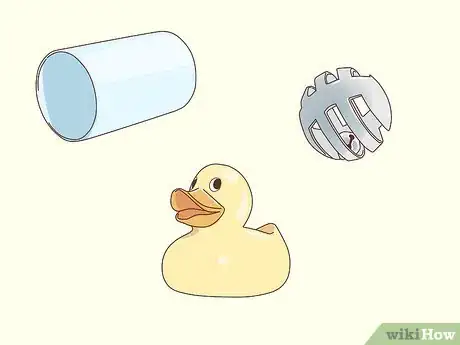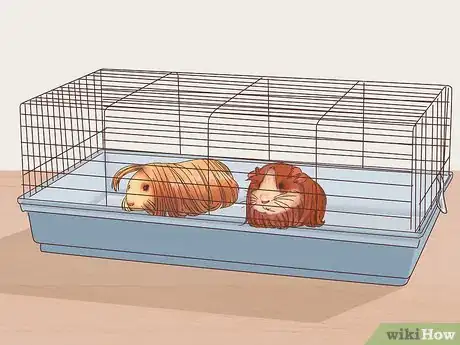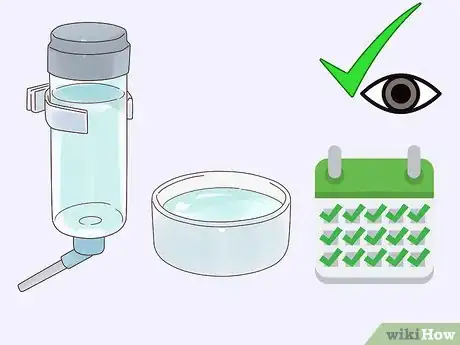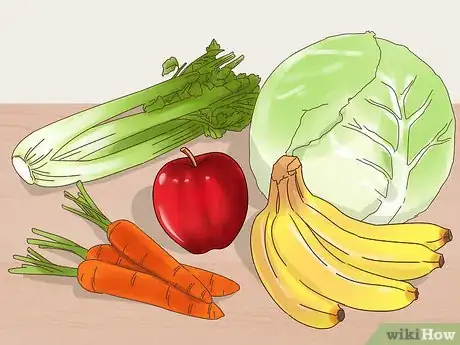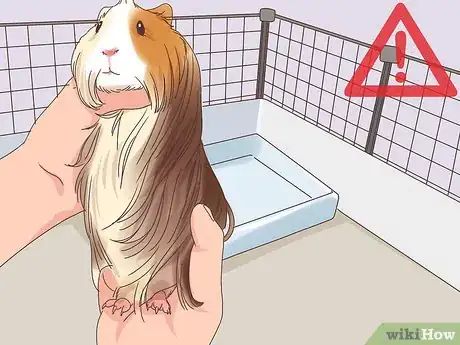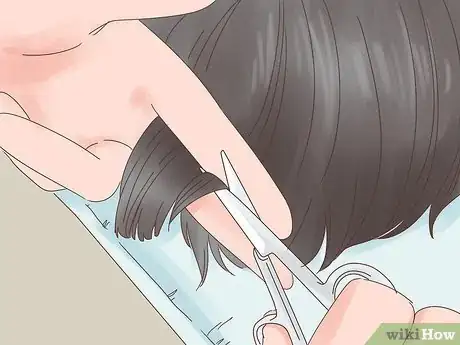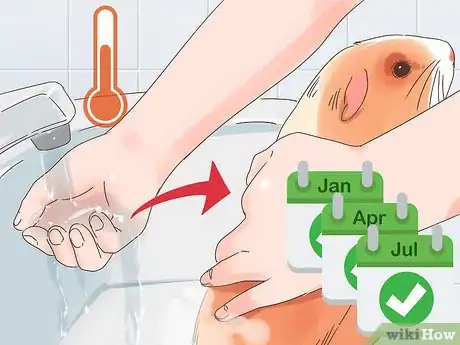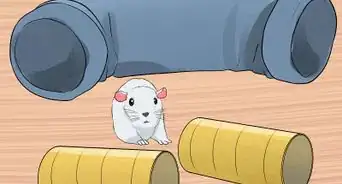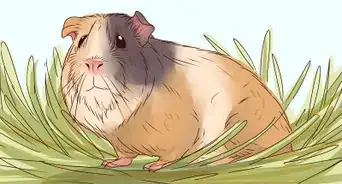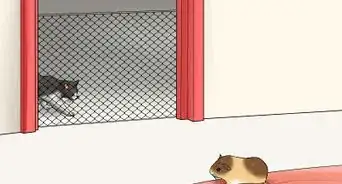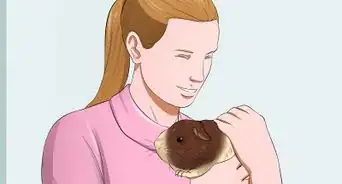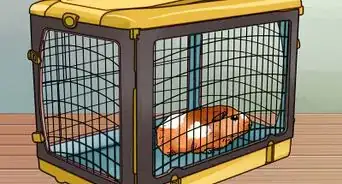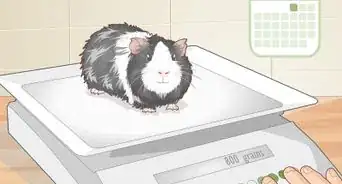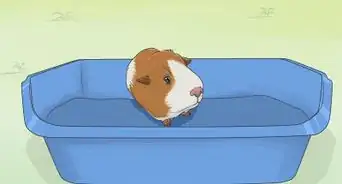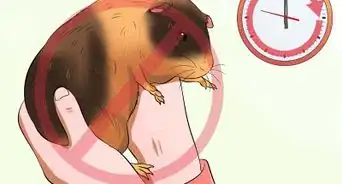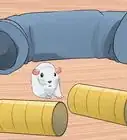This article was co-authored by Pippa Elliott, MRCVS. Dr. Elliott, BVMS, MRCVS is a veterinarian with over 30 years of experience in veterinary surgery and companion animal practice. She graduated from the University of Glasgow in 1987 with a degree in veterinary medicine and surgery. She has worked at the same animal clinic in her hometown for over 20 years.
There are 9 references cited in this article, which can be found at the bottom of the page.
This article has been viewed 20,771 times.
Peruvian guinea pigs are known for their luxurious locks of hair and sweet personalities. They require a bit more grooming than your average guinea pig, but they make up for it with their beauty. Establish a schedule for bathing, trimming, and brushing right away. Feeding your guinea pig a diet of fresh vegetables is another worthwhile investment, as it can reap clear health benefits. When all of this work is done, sit down and enjoy a quick cuddle with your Peruvian guinea pig.[1]
Steps
Creating a Suitable Environment
-
1Get the right size cage. If you own just one guinea pig, a cage measuring at least 41" x 27" (or 104cm x 68cm) will be adequate. Add more space if you decide to place another guinea pig in the same cage. Getting too small of a cage can cause behavioural issues, including territorial disputes over space.
- Opt for a wired cage from all sides with a plastic or hard base for proper ventilation.
-
2Line the bottom of the cage with absorbent bedding that is free of harmful dyes and chemicals. While wood shavings is a common option used for standard guinea pigs, the pieces of shavings will stick in your Peruvian guinea pig's hair and create matted areas. Avoid using hay or paper shredding as these options will not absorb urine or spills properly.
- If you find a single layer of bedding isn't absorbent enough, consider implementing fleece, cotton liners, or towels underneath your base bedding.
Advertisement -
3Include safe toys. Throw in a few wooden chew blocks or cut down a PVC pipe to around 4 inches (10 cm) and place it within the cage as a tunnel. Ramps and platforms are also great enrichment tools. When you choose a toy always consider the potential hazards. Can it be chewed apart? Are there any sharp or breakable pieces?
-
4Keep your guinea pigs cool. Due to their mass of hair, Peruvian guinea pigs are very vulnerable to heat. It's best to keep your home environment at a consistent temperature between 65–75 °F (18–24 °C). Move your guinea pig's cage away from any drafts, fans, or vents.
- If you know that your home is hot, you can try various cooling methods, including freezing water bottles and letting your pig lie down next to them.
-
5House two guinea pigs together. Peruvian guinea pigs are naturally social creatures and usually enjoy living with a cage mate. However, you'll need to put some thought into these pairings. For example, if you add in a male with a female, then you may end up with a breeding pair. Pairing up a younger guinea pig with an older one usually works well, as do same-sex pairings.[2]
- It's also a good idea to observe the guinea pig's personalities before mixing them. Two dominant animals will often continually fight, whereas a dominant-submissive pair will establish a hierarchy and get along nicely.
- Expect some rounds of fighting to break out, especially if one of the guinea pigs is an adolescent aged between 3-5 months. If the fighting is ongoing or results in injury, it's probably best to separate them.
Providing Daily Care
-
1Check the water dropper and food dishes every day. Take down the sipper bottle daily, rinse it out, and replace the water inside. Clean the bottle weekly using a solution of 10% bleach and 90% water. As for the food bowl, rinse it off at least once weekly with the above bleach solution. Remove uneaten food at the end of each day and wipe it down with a clean towel. To keep everything clean, it helps to have at least 2 water bottles and multiple food dishes.[3]
- Your Peruvian guinea pig will likely drink less water if it has access to lots of fresh veggies.
-
2Clean the cage daily. At a minimum, you should go into the cage and replace the soiled bedding with fresh materials each day. Some owners also prefer to scrub down the entire cage daily with a 10-1 bleach and water mixture. If you do this, make sure to let the cage dry before bringing your guinea pig back in. Keeping a clean cage will help to avoid several possible health problems.[4]
-
3Provide your guinea pig with a balanced diet. Guinea pig's have a diet consisting of 80% hay, 15% vegetables, and 5% pellets. It is essential to provide your guinea pig with fresh green hay at all times. You can also give your guinea pig fresh grass, as long as it is pesticide-free.[5]
- Provide your guinea pig with a variety of fresh fruits and vegetables and supplement their diet with pellets. Provide no more than 1/4 cup of pellets on a daily basis as they are high in calories and low in fiber, which can lead to an overweight guinea pig.
- Avoid muesli mix pellets, as these encourage selective feeding that could lead to dietary issues and teeth problems.
- Only purchase pellets that are specifically made for guinea pigs with fortified vitamin C. Check that the "milled date" on the package is recent, as the vitamins contained inside degrade overtime.[6]
- Bell peppers, cabbage, kale, spinach, cucumber, tomatoes, and broccoli are all examples of guinea pig friendly fresh foods.
-
4Handle your guinea pig carefully. Approach your guinea pig from the front and crouch down to their level. Place one hand under your guinea pig's chest and another around and under its hindquarters. Establish that you have a good grip and then slowly lift upwards. Cradle your guinea pig to your chest for more security. Never pick up your guinea pig by its shoulders or limbs, as this could lead to an injury.[7]
- Repeat this process in reverse when you need to set your guinea pig back down. The key is to move slowly and keep both of your hands on your guinea pig.
-
5Provide one hour of floor time to your guinea pig routinely. Peruvian guinea pigs are naturally curious creatures that can grow extremely bored and depressed if kept in a cage all day and night. Use cardboard to block off an interior or outside space at least once a day and let your guinea pig roam about. It's not necessary to play with your guinea pig during floor time, but they'll likely appreciate it if you do.[8]
Grooming Your Peruvian Guinea Pig
-
1Brush your guinea pig's hair regularly. Unlike other guinea pigs, Peruvians are unable to groom themselves. Get a soft brush or fine-tooth comb and work through your pet's hair from base to tip. Brush in the direction of the hair growth, usually parting down the back. Repeat this process at least twice a week.[9]
- As you brush, feel for matted areas and work these out by hand or cut them off with shears. If your guinea pig's hair stays matted it can become painful and even lead to a skin infection. If your guinea pig no longer has free range of motion in its legs, then a hair mat may be to blame.
- Expect your guinea pig to move around a bit during the first few grooming sessions. After a while, they will settle down and get used to the routine.
-
2Trim your Peruvian guinea pig's hair. When your guinea pig's hair grows past its feet and hits the floor, then it's time for a haircut. Get a pair of sharp hair shears and place a single lock of hair between your second and third fingers. Trim the ends off and repeat. Take your time and never cut too close to your guinea pig's skin or you may nick it.
- Place a bit of food before your guinea pig, like a sliced carrot. This should keep them distracted while you trim.
- Breeders of Peruvian guinea pigs often style their guinea pig's hair and then secure it with tissue and rubber bands. This keeps the style intact for longer.[10]
-
3Bathe your pig every three months at a minimum. Get a shallow plastic dish and fill it up with lukewarm water. Place your guinea pig into the container, making sure that its feet touch the bottom. Gently apply mild small animals shampoo and work it into the hair. Rinse your guinea pig off and dry them with a fluffy towel. You'll likely want to wipe off your guinea pig's hindquarters regularly in between baths to keep the area from getting soiled.[11]
- It's best to bathe your guinea pig on a low surface, just in case it escapes the water dish. You can expect your pig to squirm a bit during baths, but speaking softly and rubbing gently can calm it down.
- Be aware that most other breeds of guinea pigs are not regularly bathed. Peruvians are different because of their long hair.
- Avoid blow-drying your guinea pig after a bath, as this can scare your pet. Instead, just use a combination of towelling and air drying.
Warnings
- Be careful allowing young children to handle guinea pigs, as they may not be able to hold them properly.⧼thumbs_response⧽
- It may seem odd, but your pig will likely eat its feces on occasion. This is a regular part of digestive health for guinea pigs.[14]⧼thumbs_response⧽
References
- ↑ https://pethelpful.com/rodents/peruvian-guinea-pig-care
- ↑ https://www.animalhumanesociety.org/guinea-pig-bonding-basics
- ↑ http://guineapigowner.com/guinea-pig-diet/
- ↑ https://pethelpful.com/rodents/peruvian-guinea-pig-care
- ↑ https://pethelpful.com/rodents/peruvian-guinea-pig-care
- ↑ http://cavymadness.com/care/food.html
- ↑ http://guineapigowner.com/guinea-pig-care-in-5-easy-steps/
- ↑ http://animal-world.com/encyclo/critters/guin_pig/PeruvianGuineaPig.php
- ↑ https://pethelpful.com/rodents/peruvian-guinea-pig-care
About This Article
To care for Peruvian guinea pigs, keep them in a roomy cage and maintain a consistent temperature between 65–75 °F, since they're vulnerable to high temperatures. Remember to clean their water dropper every day and refill it with fresh water. Then, refill the food dishes daily and clean them out once a week. It's also important to replace soiled substrate daily to maintain sanitary conditions for your pigs. Since Peruvians are unable to groom themselves, brush out their fur at least twice a week and trim it whenever it grows past their little feet! For tips on feeding and handling Peruvian guinea pigs, read on!

